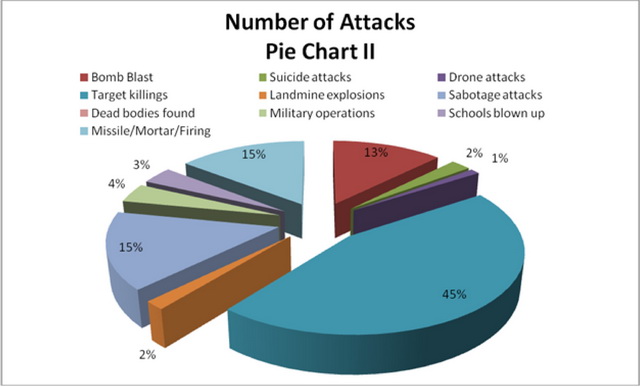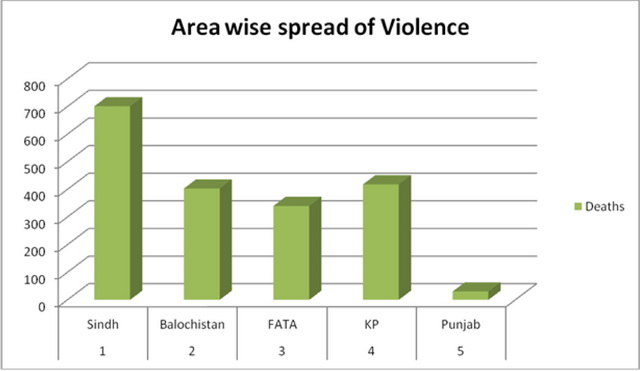The first four months of the year 2013, witnessed unprecedented surge in violence across Pakistan. Accompanied by an unusual escalation in attacks on political parties– offices and their candidates in the month of April, the ethno-political violence in Karachi, religio-political terrorism in the northwestern Federally Administered Tribal Areas (FATA) and Khyber Pakhtunkhwa (KP), and nationalist-separatist violence in Balochistan, continued to surge. The deadly wave of target killing in Sindh took over 701 lives. The data that the Centre for Research and Security Studies (CRSS) collected throughopen sources, suggests that some 2674 people lost their lives in 1108 incidents of violence across the country (for details see data sheet). The violent clashes also left 2386 people injured from January to April 2013.
A closer look into the casualty figures underlines that the civilians remained the major target of violent actors, with the civilians accounting for about 1542 deaths. Moreover, the data suggests that the militants fighting against the state emerged as the second major target i.e. 856 casualties. Clashes with militants, target-killings or ambushes of military convoys also left 276 security forces– personnel dead, mostly recorded in insurgency infested areas of FATA, Karachi and Balochistan. Furthermore, during the four months under review, as many as 12 CIA operated drone strike were reported in different areas of North Waziristan Agency (FATA), leaving about 71 suspected militants dead. Between March 2012 and February 2013, 51 drone attacks had killed over 351 suspected militants. Meanwhile, continuing their sabotage campaign against state infrastructure, militants blew up 39 state run and private schools in different parts of FATA, Balochistan and KP during the course of four months.
As a whole target killing topped as the major cause of deaths. Pie chart II above shows that 45 percent of all the violent incidents were of target killing in nature. Karachi witnessed the major loss of lives as a result of target killing. Meanwhile, bomb blasts were the second major cause of deaths. As a result of which, as many as total of 405 persons perished, including 343 civilians and 7 militants and 55 security forces personnel in different parts of the country. The third major cause of the violence was military operations. In total, 356 persons including 339 militants and 11 security personnel perished in this form of attacks. Meanwhile, from January to April 2013, 241 dead bodies were also recovered from different parts of Pakistan, most of them, were found in Karachi, Peshawar, FATA and Balochistan. Likewise, 25 suicide attacks left 168 civilians dead.
Data suggests that the southern Sindh witnessed major loss of lives during the last four month (as shown in bar chart below). After Sindh, Khyber Pakhtunkhwa turned out to be the second major hub of violence with the death toll 418, and Balochistan followed it where national- separatist and sectarian violence left almost 403 people dead during the last months. Meanwhile, violence across FATA subsided significantly during the course from January to April 2013.
Moreover, the sporadic waves of sectarian violence and religio-political violence continued to pile up misery across Pakistan, with Shia Muslims based in Quetta and Karachi becoming the frequent targets of sectarian terrorists. A precise look into the trends and territory of violence across the country underscores that the law and order situation across Pakistan continues to deteriorate. Meanwhile in first two months, ethno-political and sectarian violence in Karachi and Quetta led to the decimation of majority of the dead. Shia sect people belonging to ethnic Hazara community in Quetta continue to seethe under the deadly spate of violence unleashed by Lashkar-i-Jhangivi this year. The security situation in Balochistan continues to reel under the specter of multiple threats i.e. nationalist-separatist, sectarian, criminal, etc. Latest trends show a spate of violence in targeting the election campaign which has given rise to the religio-political violence in KP, Balochistan and Sindh.
Sources
- The News
- Dawn
- The Express Tribune
- Pakistan Today
- Daily Times
- The Frontier Post
- Jang (Urdu)
- Daily Mashriq (Urdu)
- Aaj (Urdu)
- The Nation



